 Image search results - "shukuba" Image search results - "shukuba" |

The Kusatsu Shukuba Matsuri Festival is held on April 29 to celebrate Kusatsu's history as a post town on the Nakasendo and Tokaido Roads. Numerous events and activities are held such as flea markets, street & stage performances, and Japanese danThis was the first time I saw hula dancing in Shiga. Surprised to see hula dancing (Kusatsu Station plaza).
|
|
|

The Kusatsu-juku Honjin is decorated with curtains. MAP
|
|

Shukuba Odori dance in the shopping arcade.Held 11:00 - 12:00
|
|

Start of Kusatsu Jidai Gyoretsu Procession 草津時代行列
|
|
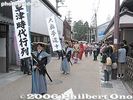
Kusatsu Shukuba Matsuri is held on April 29 to celebrate Kusatsu's history as a stage town on the Nakasendo and Tokaido Roads. The main highlight is this Kusatsu Jidai Gyoretsu procession from 11:45 am to 2 pm. This is the Tokaido Road.
|
|

Kusatsu Shukuba Festival, Shiga Pref. 大奥夢道中
|
|

Kusatsu Shukuba Festival, Shiga Pref.
|
|
|
|
|
|
|
|
|
|
|
|
|
|
|
|

Probably the highest ranking lady.
|
|

Kusatsu Shukuba Festival, Shiga Pref.
|
|
|
|
|
|
|
|

Edo Period Buddhist nun
|
|
|

Children's procession 子供奴道中
|
|

Daimyo Gyoretsu (Feudal Lord) procession 大名行列
|
|
|
|
|
|
|
|
|
|
|
|
|
|
|
|
|
|
|

Professional actor from the Toei Eiga-mura movie village.東映太秦映画村の役者
|
|
|
|
|

Palanquin かご
|
|
|
|
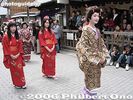
Kusatsu Shukuba Festival, Shiga Pref.
|
|
|
|
|

Kusatsu Shukuba Festival, Shiga Pref.
|
|
|
|
|
|

Kusatsu Shukuba Festival, Shiga Pref.
|
|
|

Lord's crest
|
|
|
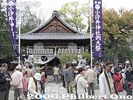
1:00 pm: Rest stop at Oshioi Shrine. 小汐井神社
|
|
|

The women only leave the shrine for their own procession.
|
|

Serving free sake.
|
|
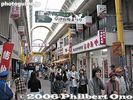
Shopping mall
|
|

Hiroshige's woodblock print of Kusatsu-juku (69th post town on the Nakasendo) from his Kisokaido series.
|
|
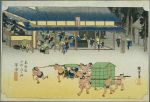
Hiroshige's woodblock print of Kusatsu-juku (53rd post town on the Tokaido) from his "Fifty-Three Stations of the Tokaido Road" series. A rest house and servants are depicted.
|
|

Bamba-juku (Banba-juku) does not have any train stations within walking distance. The closest is Maibara and Samegai Stations. Buses and taxi available. From Samegai, go on Route 21 until you reach this intersection (3 km from Bamba) where you turn left.
|
|

You will soon see this Hokuriku Highway overpass. Go under it.
|
|

Then you'll see a fork in the road. Take the smaller right road which is the former Nakasendo Road.
|
|

The island in the middle has a Bamba-juku monument.
|
|

Bamba-juku monument marking the location of the Kure Ichirizuka milestone. 久禮の一里塚 MAP
|
|

Old Nakasendo Road to Bamba-juku, the sixty-second station or post town (shukuba) of the sixty-nine stations on the Nakasendo Road.
|
|

Bamba-juku is the third Nakasendo station in Shiga, following Samegai-juku which is also in Maibara.
|
|

Finally a small sign on the left declaring "Nakasendo Bamba-no-juku."
|
|

Marker for site of a Toiya-ba which was a travel logistics office where you can get pack horses, forward your baggage, and find a place to stay in Bamba. 問屋場
|
|

Bamba today is a quiet, rural settlement. It is divided into east Bamba and west Bamba.
|
|

Another welcome sign in Bamba-juku.
|
|

Welcome sign in Nakasendo Bamba-juku. (The orange object is a mailbox.)
|
|

Site of another Toiya-ba.
|
|

Intersection with a Bamba-juku stone monument. A good place to rest and eat your box lunch.
|
|

Bamba-juku stone monument.
|
|

Next to the Bamba-juku stone monument is an old map of Bamba-juku.
|
|

Stone marker with a finger pointing the way to Maibara Port where you can board a boat to go to Otsu via Lake Biwa. This is at the same intersection across from the Bamba-juku stone monument.
|
|

Site of the Waki-Honjin on the right. Now a modern house. The Waki Honjin was the town's second-best lodge. 脇本陣跡
|
|

Close-up of stone marker for the Waki-Honjin. There are no original buildings left in Bamba-juku related to the post town, except for Rengeji temple.
|
|

Site of the Honjin, the town's most exclusive inn for daimyo lords and other VIPs. This is not the original building. Just a private house. Near the Waki Honjin. 本陣跡
|
|

Going further down the road in Bamba.
|
|

Place where Emperor Meiji took a break. It was the site of another Toiya-ba.
|
|

Marker indicating that Emperor Meiji took a break here once.
|
|

On the left of the road is the path to Rengeji temple.
|
|

Path to Rengeji temple.
|
|

Smack dab in front of Rengeji temple is this monstrosity that is the Meishin Expressway.
|
|

Right after passing under the Meishin Expressway, you see Rengeji's Sanmon Gate. 蓮華寺 山門
|
|

Rengeji is famous as the place where Hojo Nakatoki 北条仲時 and over 430 of his men committed suicide after being defeated by Ashikaga Takauji's forces during the fall of the Kamakura shogunate in 1333. This is a monument for this tragic event.
|
|

On the left of the Sanmon Gate is the "River of Blood." When Hojo Nakatoki and 430 of his men slit themselves on May 9, 1333, the blood became a river flowing here. It was during the Genko War when the Emperor Go-Daigo fought the Kamakura shogun
|
|

"River of Blood" sign. In charge of national security, Hojo Nakatoki was the last Rokuhara Tandai Kitakata chief from the Hojo clan in the Kamakura shogunate. When tourists see this sign, they become scared to enter the temple.
|
|

Rest assured, it's very peaceful in the temple. Rengeji's Sanmon Gate (right) and bell tower on left.
|
|

Wooden insignia on Sanmon Gate with the Imperial crest on the left. The temple was originally founded by Prince Shotoku Taishi about 1,300 years ago. He named it Horyuji 法隆寺. After being struck by lightning, it was rebuilt in 1284.
|
|

Rengeji temple belongs to the Jodo-shu Buddhist sect. The founding priest was Saint Ikko. With support from the lord of Kamaha Castle near Bamba, he was able to rebuild the temple and renamed it Rengeji. 一向上人
|
|

Rengeji Hondo Hall, Banba-juku, Maibara, Shiga. Quite a few emperors favored this temple. The 95th Emperor Hanazono (1297-1348) gave the temple an Imperial sanction to receive Imperial prayers. Hence, the temple's Imperial crest. 蓮華寺
|
|

Until 1943, the temple was a dojo for the Jishu Ikko sect. It then converted to Jodo-shu. Admission is charged, I think 300 yen. There's a unmanned collection box near the entrance.
|
|

Red plum blossoms in front of Rengeji Hondo Hall, in early April.
|
|

Inside Rengeji Hondo Hall, left altar.
|
|

Inside Rengeji Hondo Hall, main altar at the center. There are two figures: Amida Nyorai and Shaka Nyorai. Jodo-shu Buddhist sect. 蓮華寺 本堂
|
|

Inside Rengeji Hondo Hall, main altar at the center. 蓮華寺 本堂
|
|

Inside Rengeji Hondo Hall, right altar.
|
|

Rengeji Hondo Hall's framed nameplate. The temple's name was written by Emperor Go-Mizunoo (1596–1680).
|
|

This is the area where Hojo Nakatoki and his men committed seppuku.
|
|
|

Bell tower. Cast during the time of Saint Ikko, the bell is an Important Cultural Property.
|
|

Inside is a Jizo-son statue worshipped for transportation safety.
|
|
|

Memorial for victims of the Pacific War.
|
|

Monument for a poem by Saito Mokichi (1882-1953). 斉藤茂吉の歌碑 「松風の音を聞くときは 古への 聖の如く 我は寂しむ」
|
|

Grave of the lord of Kamaha Castle who helped to rebuild the Rengeji temple.
|
|

Way to the graves of Hojo Nakatoki and his men who committed suicide.
|
|

A few steps up a slope.
|
|

Memorial for Hojo Nakatoki and his men. They had lost to Ashikaga Takauji in the battle at Kyoto and were trying to escape to Kamakura, but was caught by Takauji's forces at Bamba.
|
|

Over 430 gravestones. Hojo Nakatoki and his men were besieged in Bamba by Southern Imperial Court forces. They fought back, but lost and slit their bellies in front of Rengeji's Hondo main hall.
|
|

The temple's third priest wrote the names and age (youngest was 14) of the known fallen warriors in a scroll. He also made these gravestones for them. Visuallly, it's very impressive edifice.
|
|

Graves of Hojo Nakatoki and his men from the Rokuhara Tandai. 北条仲時一行の墓
|
|

The gravestones have five levels. In fall, the surrounding maple leaves turn blood red.
|
|

There are more steps which lead to graves of temple priests and Saint Ikko's mausoleum.
|
|

Graves of previous temple priests.
|
|

Mausoleum of Saint Ikko Shunsho.
|
|

Small mausoleum for Saint Ikko. 一向上人の御廟
|
|

Side of the Hondo
|
|

Behind the Hondo hall is a small hill with the Bamba Chutaro Jizo-son statue.
|
|
|

Bamba Chutaro Jizo-son statue, based on a character in the novel "Mabuta-no-Haha" 瞼の母 by Hasegawa Shin (1884-1963) 長谷川伸. 番場忠太郎
|
|

View behind the Hondo.
|
|

Also behind the Hondo is this Ikko-sugi tree, 700 years old. Named after the temple's founding priest Saint Ikko, it was planted where Ikko was cremated. Over 30 meters high and 5 meters wide. 一向杉
|
|

Temple garden. Best during spring when the flowers bloom.
|
|

View from Hondo hall.
|
|

From Rengeji temple, a short distance away on the Nakasendo Road is this path to Naotaka Shrine.
|
|

Naotaka Shrine, dedicated to Lord Ii Naotaka, the third lord of Hikone Castle. 直孝神社
|
|

Naotaka Shrine torii
|
|

There's no explanation about the shrine.
|
|

Naotaka Shrine
|
|

The shrine has no human staff, but a security camera operates.
|
|

Naotaka Shrine Honden Hall
|
|
|
|
|

Turn left to hike to Kamaha Castle ruins. 鎌刃城
|
|

Map of Kamaha Castle. 鎌刃城
|
|

Path to Kamaha Castle, a mountaintop castle in the distance. Only stone walls remain. 鎌刃城
|
|

Kitano Shrine
|
|

Bamba-juku monument
|
|

A stone found in a river bank. Since it has a hole, it is thought to be a foundation stone for a building's pillar.
|
|
|
|

From Kashiwabara-juku, heading toward Samegai-juku.
|
|
|

Stone marker between Azusa and Kashiwabara-juku.
|
|
|
|

Kawauchi stone monument
|
|

Nakasendo stone marker. Go left to enter the old Nakasendo Road.
|
|

Nakasendo Road on left, entering Samegai-juku. On the right is Route 21 going to Maibara Station.
|
|

Nakasendo Road going to Samegai-juku.
|
|

Hachiman Shrine
|
|

Site of Ichirizuka milestone on left.
|
|

Ichirizuka milestone 一里塚
|
|
|
|

Samegai-juku is the sixty-first station or post town (shukuba) of the sixty-nine stations on the Nakasendo Road. It is the second Nakasendo station in Shiga (following Kashiwabara-juku), MAP
|
|
|

Samegai-juku stone monument
|
|

Samegai-juku and Nakasendo Road 醒井宿
|
|
|

Kamo Shrine is one of the first things that catches your eye as you enter Samegai. It's shrine on a steep slope. 加茂神社
|
|
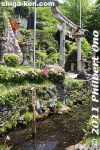
In front of Kamo Shrine is crystal clear water from a natural spring called Isame no Shimizu. This is the source of Samegai's famous Jizogawa River and one of Japan's 100 Famous Springs of the Heisei Period.
|
|
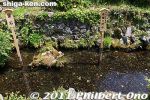
Samegai is famous for its Three Spring Waters and Four Rocks.
|
|

This is one of Samegai's famous Three Spring Waters. This one, in front of Kamo Shrine, is called Isame-no-Kiyomizu. 居醒の清水
|
|
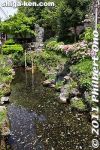
Isame no Shimizu is the natural spring which is the source of Jizogawa River. The name "Samegai" also comes from this spring. 居醒の清水
|
|

About Isame no Shimizu and Yamato Takeru.
|
|
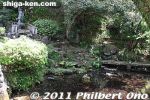
Next to Isame no Shimizu is a statue of Yamato Takeru.
|
|
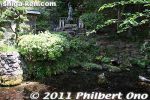
Isame-no-Kiyomizu spring was supposedly where famed warrior Yamato Takeru bathed to heal his wounds after battling an evil boar on Mt. Ibuki.
|
|
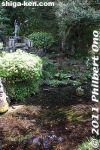
Yamato Takeru was a legendary prince and warrior who traveled a lot and defeated his enemies. However, he met his demise at Mt. Ibuki when he battled an evil god disguised as a white boar.
|
|
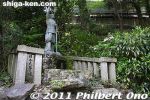
Statue of Yamato Takeru at Samegai's water spring. He defeated the boar, but not before the boar showered him with poisonous rain. He went to Isame no Shimizu whose waters healed him. Then he went on to Ise, but died soon afterward. 日本武尊の�
|
|
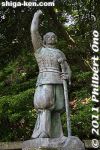
Statue of Yamato Takeru in Samegai-juku's water spring. It is not certain that this was the spring which Yamato Takeru used. Another theory says that he used Tamakurabe Clear Spring in Sekigahara, Gifu.
|
|
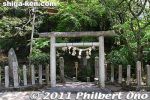
Torii gate to Isame no Shimizu spring waters.
|
|
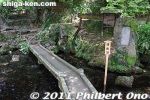
Rock where Yamato Takeru sat.
|
|
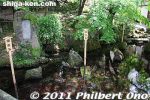
Three of Samegai's famous rocks are here, indicated by these wooden signs. 鞍懸石
|
|
|
|
|
|
|

Jizo-do temple houses a Jizo statue. Originally built by the Ogaki Castle lord Ishikawa Hyuga 石川日向守 in the Edo Period after he recovered from illness. The temple holds the Jizo-bon festival in Aug. 地蔵堂
|
|
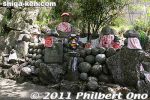
Jizo statues in Samegai. In 817, the priest Saicho carved a Jizo statue in Samegai and prayed for rain during a drought. It then rained heavily for three days. The Jizo was originally placed in the river to prsy for the souls of the fish.
|
|

Crystal-clear Jizogawa River 地蔵川
|
|
|
|
|

Jizogawa River was also noted for a freshwater fish called hariyo or stickleback. However, researchers have found that the hariyo seems to have become extinct here by May 2010.
|
|

Samegai Wooden Sculpture Museum, open only on weekends and national holidays. Closed in winter. 醒井木彫美術館
|
|

Site of Honjin lodge. 本陣跡
|
|

Samegai Museum in a former toiya-ba. 米原市醒井宿資料館 醒井宿問屋場(旧川口家住宅)
|
|
|

Inside the former toiya-ba.
|
|

Fire hose
|
|

Jizogawa River was also noted for a freshwater fish called hariyo or stickleback. However, researchers have found that the hariyo seems to have become extinct here by May 2010.
|
|

Apparently someone released a similar species called itoyo into the river and they crossbred. Researchers found the hybrid fish, but no pure-breed hariyo. This has come as a shock to the locals. Hariyo is on Japan's endangered list.
|
|

Underwater baikamo flowers Jizogawa River, Samegai, Shiga Pref. 梅花藻、バイカモ MAP
|
|

Underwater baikamo flowers Jizogawa River, Samegai, Shiga Pref. Bloom in summer, only in very clean water. 梅花藻、バイカモ
|
|

Samegai-juku and Nakasendo Road. The main part of Samegai-juku is near JR Samegai Station on the JR Tokaido Line. Short walk. 醒井宿
|
|
|

Emperor Meiji rested here.
|
|

Monument indicating that Emperor Meiji rested here.
|
|

Samegai Kominkan Community Center
|
|
|
|
|
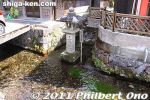
The second of Samegai's famous Three Spring Waters. This one is called Juo-sui. 十王水
|
|
|
|

Samegai Museum in a former post office designed by William Merrell Vories, Samegai, Shiga Pref. 旧醒井郵便局局舎 MAP
|
|
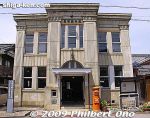
Samegai Museum in a former post office designed by William Merrell Vories, Samegai, Shiga Pref. 旧醒井郵便局局舎 MAP
|
|

Inside post office designed by William Merrell Vories.
|
|

Natural spring called Saigyo-sui. 西行水
|
|

Natural spring called Saigyo-sui. 西行水
|
|

The third of Samegai's famous Three Spring Waters. This one is called Saigyo-sui, named after the famous poet. 西行水
|
|

Saigyo-sui must be clean enough to drink.
|
|
|

Stone marker pointing to Bamba-juku, the next post town.
|
|

Road marker showing the way.
|
|

Tokaido Line train near Samegai.
|
|
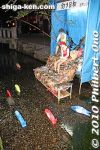
On Aug. 23 and 24, Samegai's Jizo-do temple holds the annual Jizo-bon festival at night. The Nakasendo Road has food stalls and displays of paper mache figures. 地蔵盆
|
|
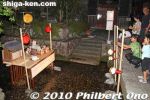
Jizo-bon is held along the Nakasendo road with various displays of paper mache figures made by local school children.
|
|
|
|
|
|
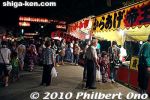
Jizo-bon in Samegai, Maibara.
|
|
|
|
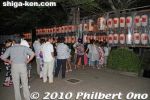
People line up at Jizo-do temple to pray to Jizo.
|
|
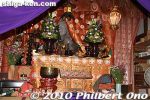
Jizo altar at Jizo-do temple in Samegai, Maibara.
|
|
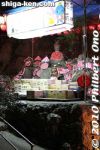
Jizo statues during Jizo-bon.
|
|
|
|
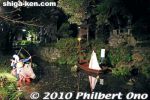
Figures at Isame-no-Kiyomizu spring during Jizo-bon festival.
|
|
|
|
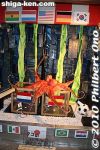
Fortune-telling octopus.
|
|
|
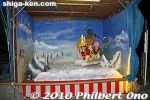
Some displays move.
|
|
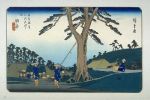
Hiroshige's print of Samegai-juku in his Kisokaido series.
|
|

Samegai Station, on JR Tokaido Line 醒ケ井駅
|
|

Mizunoeki rest house next to Samegai Station
|
|

Exhibition space in Mizunoeki arcade 2nd floor
|
|
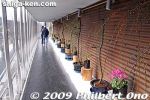
Exhibition space in Mizunoeki
|
|
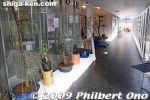
Exhibition in Mizunoeki
|
|
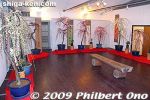
Exhibition in Mizunoeki
|
|
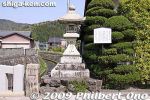
Stone lantern where the bulletin board was. Kashiwabara-juku was most famous for mogusa (moxa cautery) picked from Mt. Ibuki.
|
|
|
| 979 files on 4 page(s) |
1 |
 |
|